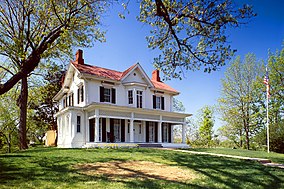Frederick Douglass House
| Frederick Douglass National Historic Site | |
|---|---|
 |
|
| Location | Washington, D.C., USA |
| Nearest city | Washington, D.C. |
| Coordinates | 38°51′48″N 76°59′07″W / 38.86333°N 76.98528°WCoordinates: 38°51′48″N 76°59′07″W / 38.86333°N 76.98528°W |
| Area | 9 acres (3.6 ha) |
| Established | February 12, 1988 |
| Visitors | 23,226 (in 2005) |
| Governing body | National Park Service |
| Website | Frederick Douglass National Historic Site |
The Frederick Douglass National Historic Site, administered by the National Park Service, is located at 1411 W St., SE in Anacostia, a neighborhood east of the Anacostia River in Southeast Washington, D.C.. Established in 1988 as a National Historic Site, the site preserves the home and estate of Frederick Douglass, one of the most prominent African Americans of the 19th century. Douglass lived in this house, which he named Cedar Hill, from 1877 until his death in 1895. Perched high on a hilltop, the site also offers a sweeping view of the U.S. Capitol and the Washington D.C. skyline.
The site of the Frederick Douglass home was originally purchased by John Van Hook circa 1855. Van Hook built the main portion of the present house soon after taking possession of the property. For a portion of 1877 the house was owned by the Freedom Savings and Trust Company. Later that year Douglass purchased the home and eventually expanded its 14 rooms to 21, including two-story library and kitchen wings. The house has an "L" shape and its plan is reminiscent of the design of Andrew Jackson Downing.
With the election of President Rutherford B. Hayes in 1876, Douglass hoped for a political appointment, likely postmaster for Rochester, New York or ambassador to Haiti. Instead, he was appointed marshal for the District of Columbia, a role which he accepted. His appointment to this highly visible position marked the first time a black man successfully received a federal appointment requiring Senate approval. Douglass, however, was not asked to fill many of the roles expected of a marshal. Typically, the marshal would attend formal White House gatherings and directly introduce guests to the President. Douglass, excused from this role, later complained that he should have resigned because of the slight. Still, the job brought him financial stability and, in 1878, he purchased the 20-room Victorian home on nine acres which they named Cedar Hill. He bought an additional 15 acres around the property the next year.
...
Wikipedia



